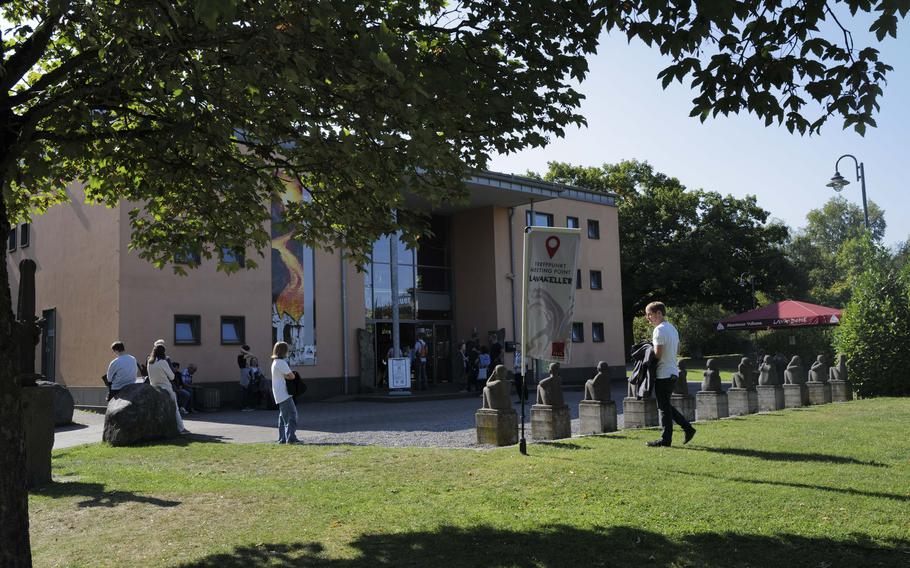
Visitors wait at the entrance of the Lava Dome for the start of their tour Sept. 21, 2024, in Mendig, Germany. The museum serves as an introduction to the geological wonders of the area, offering insight into the volcanic forces that shaped the region. (Alexander Riedel/Stars and Stripes)
It’s a simple and popular science class experiment: a volcano made with baking soda and vinegar erupts, spewing foam onto the table.
In Germany’s Eifel region, viewing the power of volcanic forces doesn’t require a school lesson, just a visit to the placid city of Mendig.
Beneath the surface lies a network of basalt caves carved by human hand from ancient lava flows. The Mendig Lava Caverns make up the largest basalt mine of its kind in the world.
On a recent sunny Saturday, my wife and I ventured to the town of Mendig, an hour from Spangdahlem Air Base, to start our day at the German Volcano Museum, also known as the Lava Dome. Opened in 2005, it provides an engaging and family-friendly introduction to vulcanology.
We started our tour in the immersive Vulkankino, where a simulated volcanic eruption made the ground tremble beneath us as wind blew in our faces. The lights dimmed and the screen erupted into chaos as a plume of ash spewed into the sky.
With a bit of imagination, we could picture ourselves standing in the midst of the cataclysm. Though the short presentation was in German, it was a worthwhile stop.
For the rest of the museum, we downloaded a free English audio guide from the website, which we started using in the second-floor Volcano Workshop.
Here, visitors get hands-on experiences like walking on a vibrating stand simulating tectonic plate shifts.
The Lava Dome’s collection of volcanic rocks and artifacts is as impressive as it is informative. One highlight for me was the “Lava Bomb.” This 159-pound basalt boulder was catapulted into the sky 13,000 years ago during the cataclysmic eruption of the Laach Lake volcano.
One of my favorite exhibits bridged the gap between past and present with a believable mock TV news clip that reported on a fictitious new eruption of the Laach Lake volcano.
It played out like a real emergency broadcast, detailing the catastrophic effects a modern-day eruption would have on this part of Germany. The chances of such an outbreak are remote, we learned, but can’t completely be ruled out by experts.
While the museum is fascinating, the true star of the show is the lava caves, whose entrance is located a few hundred yards from the museum in the courtyard of a former Mendig beer brewery.
A visit to the cavernous underground requires a professional escort, so after our museum visit, we met a smiling museum tour guide on one of the daily public tours and donned helmets and rain jackets before descending into the depths.
The cool air hit us as we made our way down the steep stairs, 105 feet below the surface, where the temperature is a steady 45 to 48 degrees Fahrenheit year-round.
After our eyes adjusted to the dark, we were stunned by the high, patterned ceilings towering above us, supported by massive hexagonal basalt columns created by the cooling and cracking of ancient lava flows. The distinctive geometric shapes of the columns, once hidden from sight under the earth, inspired awe.
While the tour guide delivered his anecdotes in German, we continued to tune into the mobile cellphone guide to learn how these manmade caverns, which stretch up to 1 square mile underneath the town, are not just geological marvels but also an important part of Mendig’s history.
Beginning in the Middle Ages, miners painstakingly quarried the basalt by hand, shaping it into building material and millstones. Later, the caverns found a new purpose: beer storage. With 28 breweries once operating in the area, they were ideal for keeping beer cool, long before the advent of refrigeration.
However, following the arrival of commercial refrigeration in the beverage industry and closure of mining operations in the 1980s, some of the shafts became dumping grounds.
As we wandered through the dark tunnels, piles of discarded items from the past decades, now preserved in the cool cavern air, were stacked floor to ceiling, a stark reminder of how these historic spaces have once been misused.
After that, we walked to Vulkan Brewery, the only one left in Mendig. The beer here is still cooled in the old volcanic caverns, and after a long walk underground, the crisp, refreshing drink was a great way to cap off our visit to the museum.
We rounded out our trip with a drive to Laach Lake, only a few minutes away. The lake sits in the volcanic caldera. At the museum, we learned that though the last eruption was thousands of years ago, minor seismic activity and escaping volcanic gases today hint that the volcano below is not entirely dormant.
But that reminder didn’t stop us from enjoying a stroll along its shores, a positively placid way to top off our fun and informational journey.
Lava Dome: German Volcano Museum in Mendig
Address: Brauerstrasse 1, Mendig, Germany
Hours: Tuesdays-Sundays, 10 a.m.-5:30 p.m., with last entry at 4:45 p.m. Hours vary on Mondays and holidays. On Dec. 31, 10 a.m.-3 p.m. Closed from the second Sunday of December until Dec. 25, and from the end of Christmas holidays until Jan. 31. Also closed during Carnival, from Mardi Gras through Shrove Tuesday.
Cost: Admission for the lava dome visitor center and caverns is 9.50 euros for adults and 7.50 for kids under 16. Family pricing is available, with a cost of 7.80 euros for parents and 6.30 euros for children. Kids under 3-foot-2 get in free.
Information: www.lavadome.de/en/lava-dome/